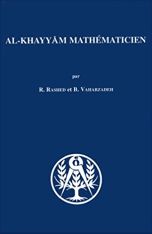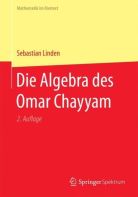PARTIE I
THÉORIE GÉOMÉTRIQUE DES ÉQUATIONS ALGÉBRIQUES
INTRODUCTION
Al-Khayyám : Mathématicien et philosophe 3
Les travaux d’al-Khayyám 6
Le projet algébrique d’al-Khayyàm 7
Al-Khayyám et Descartes 12
Théorie géométrique des équations algébriques:
L’achèvement du programme d’al-Khayyám 14
De ia géométrie à l’algèbre: les courbes et les équations 20
COMMENTAIRE MATHÉMATIQUE
Traité d’algèbre et d’al-muqábala 31
Équations du troisième degré 31
Équations qui contiennent l’inverse de l’inconnue et ses trois
premières puissances 87
Al-Khayyám et Abú al-Júd ibn al-Layth: à propos de l’équation 17 88
Traité sur la division d’un quart de cercle 98
HISTOIRE DES TEXTES
Traité d’algèbre et d’al-muqábala 109
Traité sur la division d’un quart de cercle 113
TEXTES ET TRADUCTIONS
Traité d’algèbre et d’al-muqábala 116
Traité sur la division d’un quart de cercle 238
PARTIE II
THÉORIE DES PARALLÈLES ET THÉORIE DES PROPORTIONS
INTRODUCTION
La théorie des parallèles 271
Les concepts de rapport et de proportionnalité 274
La composition des rapports 277
COMMENTAIRE MATHÉMATIQUE DU TRAITÉ D’AL-KHAYYAM SUR LES ÉLÉMENTS D’EUCLIDE
La théorie des parallèles 281
Les concepts de rapport et de proportionnalité 290
La composition des rapports et la notion de nombre irrationnel 298
HISTOIRE DES TEXTES
Les manuscrits du Commentaire d’al-Khayyám 301
Les éditions du Commentaire d’al-Khayyám 302
Les traductions du Commentaire d’al-Khayyám 303
L’établissement du texte et la traduction 304
TEXTE ET TRADUCTION
Commentaire sur les difficultés de certains postulats de l’ouvrage
d’Euclide 306
NOTES COMPLÉMENTAIRES
Traité d’algèbre et d’al-muqàbala 385
Traité sur la division d’un quart de cercle , 388
APPENDICE: Traité sur les Équations de Sharaf al-Din al-Tûsi, Oeuvres mathématiques. Algèbre et géométrie au xiie siècle, Texte établi et traduit par Roshdi Rashed, Paris, 1986 (Errata) 391
Index des citations 395
Index des noms propres 397
Glossaire arabe-français 399

